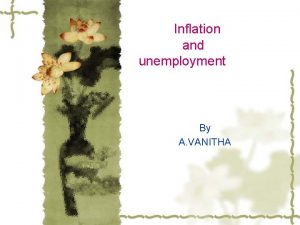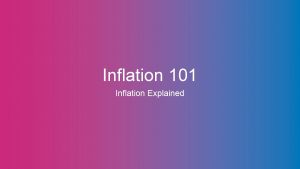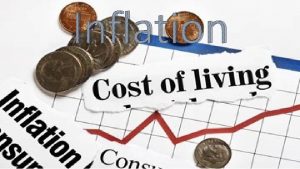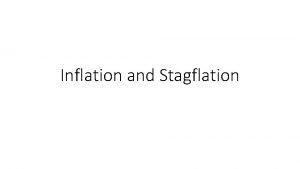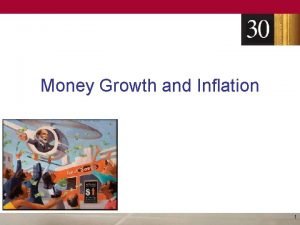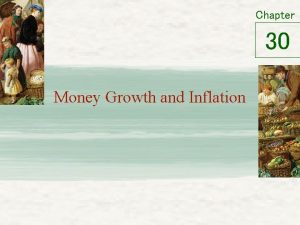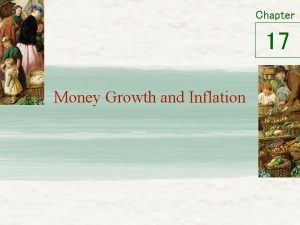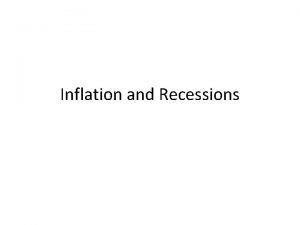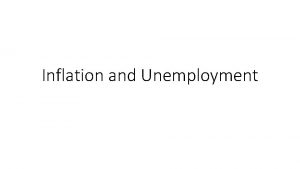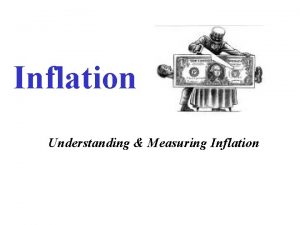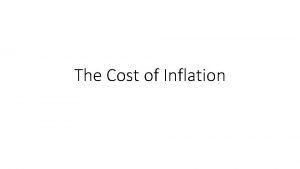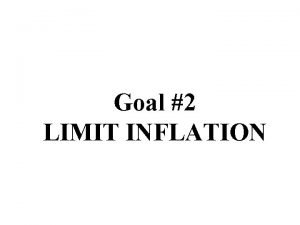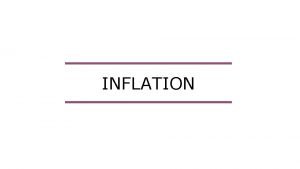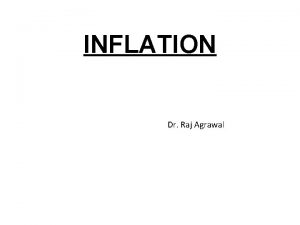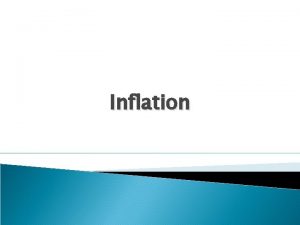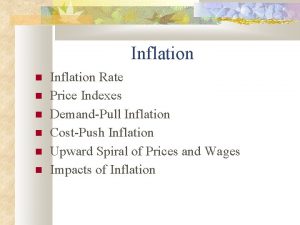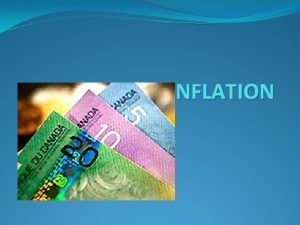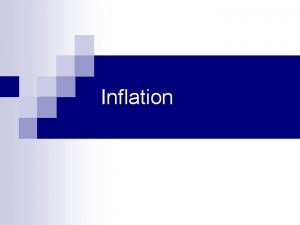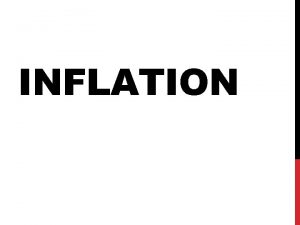Terms and Definition Inflation Definition Inflation is the


























- Slides: 26

Terms and Definition

Inflation Definition: Inflation is the rate at which the cost of goods and services rises over time. • It could also be thought of as a reduction in the value of a currency/dollar, because consumers are now able to purchase less than they once could with the same currency/dollar bill. Inflation target: 2% Types of Inflation: There are four major type of Inflation: Creeping Inflation: 3% Walking inflation: above 2% but less than 10% Running inflation: 10% - 20% Hyper inflation: around 50% in a month

How to measure Inflation Measures: Inflation can be measured in two ways a. Consumer Price Index (CPI): A consumer price index (CPI) measures changes in the price level of market basket(approximately 80, 000 specific goods and services) of consumer goods and services purchased by households. The goods and services fall into eight major categories: 1. 2. 3. 4. 5. 6. 7. 8. food and beverage, housing, apparel, transportation, medical care, recreation, education and communication, and other.

How to measure Inflation: Consumer Price Index (CPI):

How to measure Inflation: Consumer Price Index (CPI) A typical household of a nation buys 4 loaves of bread, 3 pounds of cream cheese and 8 books each week. The prices of these goods in years 2015, 2016 and 2017 are given in the table below: 1. 2. 3. 4. Year Price of a loaf of bread Price of a pound of cream cheese Price of a book 2018 5 15 50 2019 10 30 100 2020 15 30 125 Calculate the CPI in 2020, using 2019 as the base year. Calculate the CPI in 2018, using 2017 as the base year Calculate the rate of inflation between 2018 & 2019. Calculate the rate of inflation between 2019 & 2020.

How to measure Inflation: Personal Consumption Expenditures (PCE): Personal consumption expenditures is a measure of national consumer spending. It tells you how much money a nation spend on goods and services. The goods category includes two sub-categories. • Consumer durable goods are long-lasting items, such as cars and washing machines. • Non-durable goods are items that households use quickly, like groceries and clothing.

Causes of Inflation The inflation rate can rise in many different ways, and they can be taken under two different categories: Cost-push inflation and demand-pull inflation. Cost-push Inflation: Cost push inflation is a situation in which the overall price level go up (inflation) due to the increase in the cost of wages and raw materials. • Prices are driven up by the rising costs to make or provide the goods and services. This can cause a supply shortage, but the demand for the goods and services has not decreased. • Rise of wages also trigger cost-push inflation up.

Causes of Inflation Demand-pull Inflation: Demand-pull inflation results from strong consumer demand. Many individuals purchasing the same good will cause the price to increase, and when such an event happens to a whole economy for all types of goods, it is called demand-pull inflation. • Demand-pull inflation can be the sort of inflation businesses dream about. • Often demand-pull inflation can develop as a result of too much money being made, devaluing the currency and requiring an increase in price.

Effects of Inflation: üThe impact of inflation affect many different groups when it hits. Not every group is affected the same way. üGenerally in a period of mild inflation, job-seekers will get benefit. üIf inflation increased, spending can cause increased demand, and companies may decide to hire new employees for better management of the new demand. üIf someone has borrowed money from a lender, inflation could be convenient for him. With the currency devalued, what someone borrowed a year or two ago is now the equivalent to a lower amount of money.

Effects of Inflation: üIn assumed manageable level of inflation, businesses that sell goods and services can benefit as well. A healthy amount of inflation is said to increase and incentivize spending more. üAn unhealthy, unmanageable level, however, is disastrous for nearly everyone. üIf inflation spirals out of control, people lose faith in their currency. üFinancial institutions suffer as people pull their money out of them. üBusinesses suffer as their goods become too expensive for most people.

Inflation Example: Bangladesh Inflation Rate (CPI)

Gross Domestic Product (GDP) Definition: Gross domestic product (GDP) is the monetary(financial) value of all the finished goods and services produced within a country's borders in a specific time period. üGDP is usually calculated annually but it can be calculated on a quarterly basis as well. ü GDP includes all private and public consumption, government outlays, investments, private inventories, paid-in construction costs and the foreign balance of trade ( exports are added, imports are subtracted). üGDP is a broad measurement of a nation’s overall economic activity. üTextile sector contributes more than 12% in GDP of Bangladesh.

How to Determine GDP? There are three primary methods by which GDP can be determined. 1. The expenditure approach, 2. The output or value added or production approach 3. The income approach

How to Determine GDP? The expenditure approach: The expenditure approach or spending approach, which is the most common method, calculates the monies spent by the different groups that participate in the economy. For example, the activities those contribute to the GDP of a country are § Consumers spend money to buy various goods and services § Businesses spend money as they invest in their business activities (e. g. buying machinery) § Governments spend money. § Country’s net spending on exports and imports.

A country's gross domestic product can be calculated using the following formula: GDP = C + G + I + NX. • C is equal to all private consumption, or consumer spending, in a nation's economy, • G is the sum of government spending, • I is the sum of all the country's investment, including businesses capital expenditures and • NX is the nation's total net exports, calculated as total exports minus total imports (NX = Exports - Imports).

How to Determine GDP The output or value added or production approach: The production approach is something like the reverse of the expenditure approach. The production approach estimates the total value of economic output and deducts costs of intermediate goods that are consumed in the process, like materials and services.

How to Determine GDP The income approach: This approach calculates National Income, NI. NI is the sum of the following components: 1. 2. 3. 4. Labor Income (W) Rental Income (R) Interest Income (i) Profits (PR)

How to Determine GDP Income Approach: NI = W + R + i + PR 1. Labor Income (W): Salaries, wages, and benefits such as health or retirement. This also includes unemployment insurance and government taxes for Social Security. 2. Rental Income (R): This is income received from property of households e. g. land. 3. Interest Income (i): Income received by households through the lending of their money to corporations and business firms. Government and household interest payments are not included in the national income. 4. Profits (PR): The amount firms have left after paying their rent, interest on debt, and employee compensation.

Gross National Income (GNI) Gross national income (GNI) is a measure of a country's income. GNI is the sum of a nation's gross domestic product(GDP) and the net income it receives from overseas. The gross national income (GNI), previously known as gross national product (GNP), Gross National Income is conceptually equivalent to Gross National Product, but it is calculated using incomes instead of output. GNI is the total domestic and foreign output claimed by residents of a country, consisting of gross domestic product (GDP), plus factor incomes earned by foreign residents, minus income earned in the domestic economy by nonresidents. GNI= GDP + Money flowing from foreign countries- Money flowing to foreign countries.

Purchasing power parity (PPP) Concept: üThe idea is originated with the school of Salamanca in the 16 th century, and was developed in its modern form by Gustav Cassel in 1916, in The Present Situation of the Foreign Trade. üPPP is a theoretical exchange rate that allows to buy the same amount of goods and services in every country. Government agencies use it to compare the output of countries that use different exchange rates. üThe concept is based on the law of one price, where in the absence of transaction costs and official trade barriers, identical goods will have the same price in different markets when the prices are expressed in the same currency.

Purchasing power parity (PPP) Definition: Purchasing power parity (PPP) is an economic theory that compares different countries' currencies through a "basket of goods" approach. According to this concept, two currencies are in equilibrium when a basket of goods (taking into account the exchange rate) is priced the same in both countries. Measurement of PPP: 1. Law of one price 2. Big Mac Index 3. i. Pad Index 4. KFC Index

Wealthiest Countries in the World •

Per Capita Income Per capita income (PCI) or average income measures the average income earned person in a given area (city, region, country, etc. ) in a specified year. It is calculated by dividing the area's total income by its total population. PCI = i/P Where, PCI = per capita income i = total personal income P = total population

PCI of Bangladesh

Top 10 countries in PCI

Thank You
 Demand-pull inflation occurs when
Demand-pull inflation occurs when Polynomial classification
Polynomial classification What are the like terms in the algebraic expression
What are the like terms in the algebraic expression Hình ảnh bộ gõ cơ thể búng tay
Hình ảnh bộ gõ cơ thể búng tay Frameset trong html5
Frameset trong html5 Bổ thể
Bổ thể Tỉ lệ cơ thể trẻ em
Tỉ lệ cơ thể trẻ em Chó sói
Chó sói Chụp tư thế worms-breton
Chụp tư thế worms-breton Chúa yêu trần thế alleluia
Chúa yêu trần thế alleluia Các môn thể thao bắt đầu bằng từ đua
Các môn thể thao bắt đầu bằng từ đua Thế nào là hệ số cao nhất
Thế nào là hệ số cao nhất Các châu lục và đại dương trên thế giới
Các châu lục và đại dương trên thế giới Công thức tính thế năng
Công thức tính thế năng Trời xanh đây là của chúng ta thể thơ
Trời xanh đây là của chúng ta thể thơ Cách giải mật thư tọa độ
Cách giải mật thư tọa độ Phép trừ bù
Phép trừ bù độ dài liên kết
độ dài liên kết Các châu lục và đại dương trên thế giới
Các châu lục và đại dương trên thế giới Thể thơ truyền thống
Thể thơ truyền thống Quá trình desamine hóa có thể tạo ra
Quá trình desamine hóa có thể tạo ra Một số thể thơ truyền thống
Một số thể thơ truyền thống Cái miệng nó xinh thế chỉ nói điều hay thôi
Cái miệng nó xinh thế chỉ nói điều hay thôi Vẽ hình chiếu vuông góc của vật thể sau
Vẽ hình chiếu vuông góc của vật thể sau Biện pháp chống mỏi cơ
Biện pháp chống mỏi cơ đặc điểm cơ thể của người tối cổ
đặc điểm cơ thể của người tối cổ V cc
V cc
